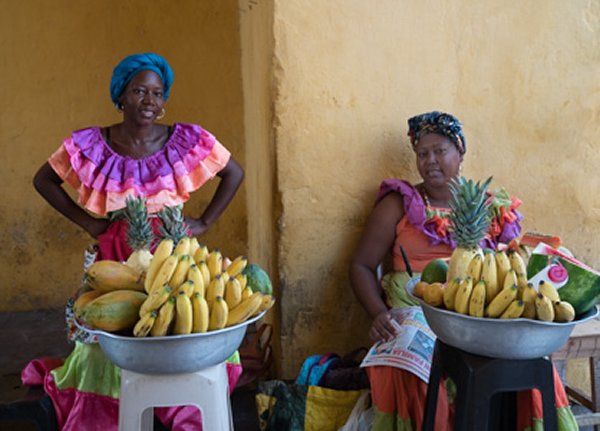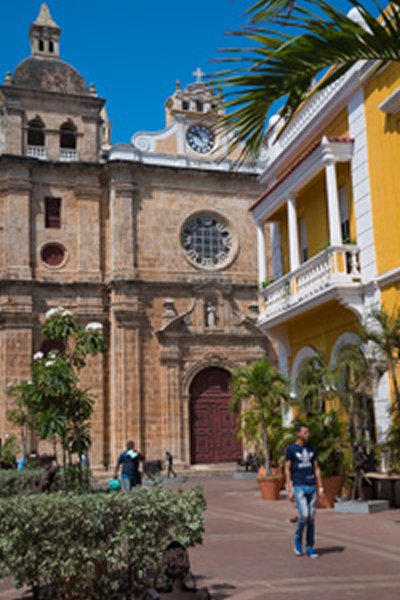Santa Marta / Cartagena - 11:14.52N 074:13.09W

Seaflute
Thu 2 Mar 2017 03:15
had imported to Grenada had not been flown on the passage from Grenada to
Bonaire. On each occasion Tom or I had even mentioned flying it, the wind
immediately blew over 20 knots, beyond the "sensible" range of the sails
performance. Given the cost and hassle involved in getting hold of this sail
I elected to be prudent and leave it in the bag. Needless to say, on the
passage to Columbia we were champing at the bit to get the big new sail
flying and predictably the wind never dropped below 20 knots for the
duration, quite the reverse, the final stretch around the Isla De La Agua,
the wind had freshened to 35 knots gusting 45. The wave height had increased
to 5m + and the threat of being pooped (waves breaking over the stern of the
yacht) was a real possibility. I had instructed all crew to wear lifejackets
with their safety lines clipped onto the cockpit wall. As we neared the
marina, I had expected the wind to abate in the lee of the headland, but not
so. The wind phenomenon on this stretch of coast is driven by the close
proximity of the Andes to the coast and the combination of the traditional
trade winds and the extreme katabatic effect from the mountains so near to
the sea. As we entered the marina we had a solid 35 knots blowing down the
fairway. As usual there was a welcoming committee of Oyster friends waiting
on the pontoon. On this occasion it was a mixed blessing, I was glad of the
assistance, but I was also digging very deep in my box of boat handling
skills and could really have done without an audience! To make matters worse
our allotted slot was alongside the beautiful brand new Oyster 575 Safiya.
The skipper stood very discreetly in the bow with a loose fender in his hand
trying not to look too concerned, but ready to pounce should I venture too
close to his charge. I reversed gingerly against the full force of the wind
until I was able to thrust the bow to starboard and reverse rapidly into
position alongside the pontoon. I was very relieved to get the lines on and
relax on the pontoon with a cold beer.
Our arrival in Santa Marta marina couldn't have been a more stark contrast
to Bonaire. The marina staff were so friendly and helpful and within half an
hour had completed all the formalities for an eleven day stay. Columbia is
such an amazing country, full of energy, sound and incredible scenery. Santa
Marta itself is a fairly big city but with a delightful old centre a short
walk from the marina. The central piazza is ringed with great bars and
restaurants which along with our Oyster friends we sampled most of! Every
night in the square the local youths would provide continuous entertainment
with music and dancing.
Lindy had booked a three night stay in a lovely boutique hotel in the old
city of Cartagena. The distance between the two cities didn't look very far
on the map but turned out to be a five hour taxi ride in practice. However
this also turned out to be a fascinating road trip including police
blockades, bandits with ropes slung across the road, but most importantly a
great insight into how poor the majority of Columbia is. The impression we
got from most of the locals we spoke with is that conditions are improving
dramatically for the general populace, since the government made peace with
the Farc rebels and the drug cartels. The government funding previously
directed to the army (500,000 soldiers, the largest army in the Americas)
predominantly employed to combat drug crime, has now been re-directed to
education and public health provisions. Every child has free schooling,
school meals and if bright enough, can qualify for a scholarship to
university. To put this into perspective, from a population of forty one
million people, last year, ten thousand students graduated from university.
The target for next year is one hundred and ten thousand.
One of the greatest challenges to the country's recovery is the number of
people displaced by the rebels from the rural areas into the cities. Only
six hundred thousand people currently live outside of cities and agriculture
is still the biggest contributor to the economy with the production of
coffee, chocolate, pineapples, bananas and coconuts. Over the last two
years, eco-tourism has grown exponentially and is expected to become the
biggest contributor to the Columbian economy within a short space of time.
Against this backdrop, it was great to experience the new found energy and
sense of hope that was tangible in all areas of the country we encountered,
other than in the very poorest.
Our visit to Cartagena was an absolute delight. The hotel was fabulous and
it was great to languish in a comfortable bed and spend as much time in the
shower as you wanted, without fear of depleting our reserves. We were
located very centrally in the old city within easy walking distance of the
bars, restaurants and major sights and our hotel provided a great base to
explore on foot all the delights this amazing city had to offer. There is no
doubt the biggest influences on its development has been Spanish. This is
reflected in the language, architecture, music and cuisine of Cartagena.
Like everywhere we've been in the Caribbean, its possession over the last
few centuries has been hotly contested by the French, English and Dutch in
equal measure. The city is surrounded by impressive fortifications that have
evolved as each assault on the city became more determined. The most
successful assault on the city was led by Sir Francis Drake, one of the most
ruthless and daring privateers to predate the Caribbean sea. His prizes
often included Spanish galleons carrying thousands of tons of Inca and Aztec
gold artefact's transited through Cartagena on route to Spain. On a walking
tour of the city with our personal guide Hugo, we were shown around the gold
museum and saw a vast collection of gold bells the ancient Indian's used to
ward off evil spirits. On one occasion, the Spanish conquistadors came upon
a town surrounded by two hundred acres of trees laden with gold bells. They
had literally found gold growing on trees. The tragedy for us was seeing the
intricacy of these and other more delicate artefact's on display and the
realisation most would have been melted down to make coins for shipment back
to Spain.
The largest castle which dominates the skyline of the city is the "Castillo
de San Felipe" we spent a morning exploring this very impressive castle
designed to defend the city from attack by either land or sea. It says a lot
about Columbia's approach to health and safety (and our stupidity), when
Lindy and I almost got completely lost in a maze of unlit tunnels below the
castle that were accessible to the public.
When back in Santa Marta, we were very keen to travel into the mountains and
rainforest inland from the city. We booked a one day tour that would take us
to a small settlement called Minka about one hours drive North. From there
we trekked to a series of waterfalls were we swam in crystal clear pools of
COLD water with an incredible rainforest backdrop. The trek to the
waterfalls was down a steep winding track and guess what? The walk back, was
UP the same steep and winding track. I think this was slightly more arduous
than some of our group would have liked! The prize at the end was a fabulous
lunch served on a lovely terrace attached to our guides bamboo house over a
steep ravine with far reaching views over the forest to the sea. Whilst we
ate, humming birds hovered in the trees around us.
Our host Joe, explained to us the history and culture of chocolate
production in Columbia. The ancient Indians used it as an aphrodisiac and
modern scientists have confirmed that when reduced to a concentrate it
contains high concentrations of dopamine and elements that increase blood
flow through minor capillaries. I'm sure most ladies reading this don't need
a scientific confirmation to tell them eating chocolate makes them feel
happy!
>From here a short walk took us to a small organic coffee farm and a detailed
walk through the cultivation and production process. ( a few nuggets of
coffee info - coffee should never be infused at a temperature higher than 80
degrees C. Nespresso is a good product because the coffee is sealed into the
canisters within seconds of grinding when the oils are still present.)
As we walked around the farm, Joe pointed out random Coca plants (cocaine)
growing there and explained to us how important coca leaves are to the
locals for use in medicines and for religious rituals. The indigenous
Indian's still routinely use coca leaves to enhance sexual performance and
traditionally sex is conducted without removing any clothes and no movement
is allowed during coupling?? I couldn't quite work out if you have the
chocolate before the coke or vice versa.
Once again, time passed too quickly and we were ready to leave Santa Marta
on the next stage of our adventure. The checkout process and grant of our
Zarpe (the official document to clear you and your vessel onto the next
port) was slightly delayed, but meant we were only three hours late leaving.
We waved a very fond farewell to Columbia......and guess what? We will be
back!
All for now
Skipper Peds







